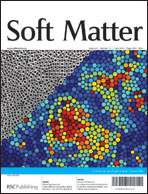The dynamics of granular media in the jammed, glassy region is described in terms of “modes”, by applying a principal component analysis (PCA) to the covariance matrix of the position of individual grains. We first demonstrate that this description is justified and gives sensible results in a regime of time/densities such that a metastable state can be observed on a long enough timescale to define the reference configuration. For small enough times/system sizes, or at high enough packing fractions, the spectral properties of the covariance matrix reveals large, collective fluctuation modes that cannot be explained by a random matrix benchmark where these correlations are discarded. We then present a first attempt to find a link between the softest modes of the covariance matrix during a certain “quiet” time interval and the spatial structure of the rearrangement event that ends this quiet period. The motion during these cracks is indeed well explained by the soft modes of the dynamics before the crack, but the number of cracks preceded by a “quiet” period strongly reduces when the system unjams, questioning the relevance of a description in terms of modes close to the jamming transition, at least for frictional grains.

You have access to this article
 Please wait while we load your content...
Something went wrong. Try again?
Please wait while we load your content...
Something went wrong. Try again?


 Please wait while we load your content...
Please wait while we load your content...